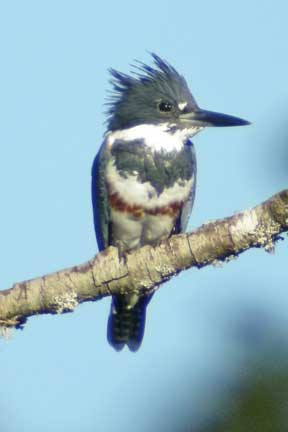 |
Previous Issues |
| Cedar Mill Community Website |
|
| Search the Cedar Mill News: | About The Cedar Mill News |
|
|||||||
| Volume 8, Issue 8 | August 2010 |
||||||
The nature of Cedar Mill
|
 |
| Female Belted Kingfisher. Photo by Jeff Young |
This past week I observed a pair of female Kingfishers sitting in the same tree. It is unusual to see more than one of these birds perched together, so this was definitely worth investigating. With the help of my binoculars it was obvious that this was a mother teaching her “chick” how to fish. Soon, the young Kingfisher in a fit of independence flew away from the pond and into my yard to inspect my bird bath. After looking confused upon not finding fish in this body of water, she responded to her mother’s call, and flew back to join her.
Molting of feathers represents another transition. Bird feathers, much like our hair, are not living tissue. When feather color changes it means the bird grew new feathers. Most species molt once or twice a year. Most water birds molt twice. This accounts for why the male Mallards in their “eclipse” (non breeding or fall) plumage look rather dull compared to their truly glorious jewel-tone green head of the spring. Soon the intense yellow of the male goldfinches will be replaced with their winter-phase dull olive feathers. Already several birds in my yard look “scruffy” due to the change-over in their molting cycle.
Yet a third transition is the change from juvenile size, behavior, and coloration to adult forms. We have had a pair of Canada Geese return to our pond every spring for the past 10 years. Each spring they hatch a number of goslings, but unfortunately they have always been taken by predators over the next several days. This year they successfully raised four babies which now are nearly the same size as the parents and can barely be distinguished by size or coloring. Seeing this pair of geese successfully rear four offspring has been truly sweet after many sad failures. Soon the youngsters will be graduating from life on their first pond to their first southward migration. Watching my son’s recent high school graduation, it seemed as though his young life had flashed by almost as fast as the childhood of our backyard young geese.
Lauretta Young is a retired physician who now teaches at PSU and OHSU and also has a bird tour business in Cedar Mill and surrounding areas—check out her web site at www.portlandbirdwatching.com for more pictures and a blog.
Published monthly by Cedar Mill Advertising & Design
Publisher/Editor:Virginia Bruce
503-803-1813
PO Box 91061
Portland, Oregon 97291